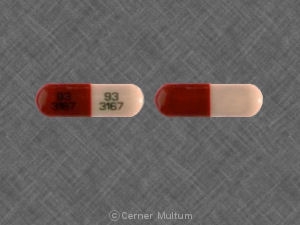



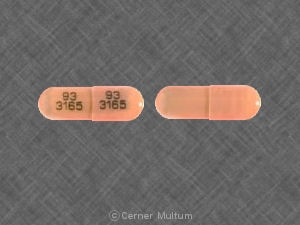
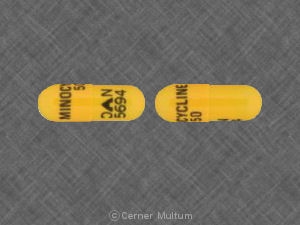
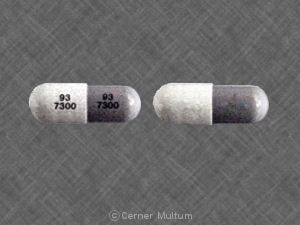
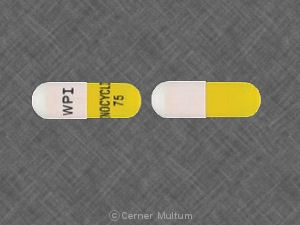
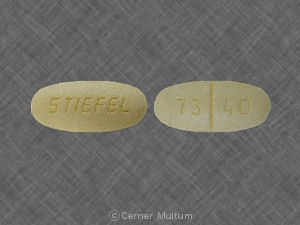
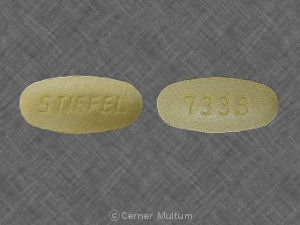
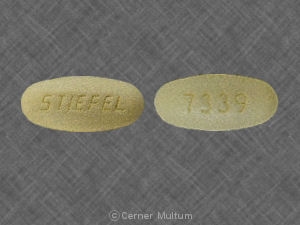
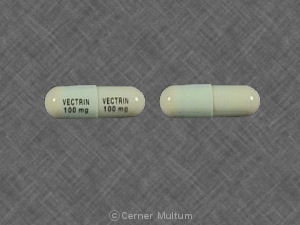
































































Components:
Treatment option:
Medically reviewed by Oliinyk Elizabeth Ivanovna, PharmD. Last updated on 26.06.2023

Attention! Information on this page is intended only for medical professionals! Information is collected in open sources and may contain significant errors! Be careful and double-check all the information on this page!
Dosage Forms And Strengths
- 45 mg extended release tablets: gray, unscored, coated, and debossed with “DYN-045” on one side.†
- 55 mg extended release tablets: pink, unscored, coated, and debossed with “DYN-055” on one side.
- 65 mg extended release tablets: blue, unscored, coated, and debossed with “DYN-065” on one side.
- 80 mg extended release tablets: dark gray, unscored, coated, and debossed with “DYN-080” on one side.
- 90 mg extended release tablets: yellow, unscored, coated, and debossed with “DYN-090” on one side.†
- 105 mg extended release tablets: purple, unscored, coated, and debossed with “DYN-105” on one side.
- 115 mg extended release tablets: green, unscored, coated, and debossed with “DYN-115” on one side.
- 135 mg extended release tablets: pink (orange-brown), unscored, coated, and debossed with “DYN-135” on one side.†
Storage And Handling
SOLODYN (minocycline HCl, USP) Extended Release Tablets are supplied as aqueous film coated tablets containing minocycline hydrochloride equivalent to 55 mg, 65 mg, 80 mg, 105 mg, or 115 mg minocycline, are supplied as follows.
The 55 mg extended release tablets are pink, unscored, coated, and debossed with “DYN-055” on one side. Each tablet contains minocycline hydrochloride equivalent to 55 mg minocycline, supplied as follows:
NDC 99207-465-30 Bottle of 30
The 65 mg extended release tablets are blue, unscored, coated, and debossed with “DYN-065” on one side. Each tablet contains minocycline hydrochloride equivalent to 65 mg minocycline, supplied as follows:
NDC 99207-463-30 Bottle of 30
The 80 mg extended release tablets are dark gray, unscored, coated, and debossed with “DYN-080” on one side. Each tablet contains minocycline hydrochloride equivalent to 80 mg minocycline, supplied as follows:
NDC 99207-466-30 Bottle of 30
The 105 mg extended release tablets are purple, unscored, coated, and debossed with “DYN-105” on one side. Each tablet contains minocycline hydrochloride equivalent to 105 mg minocycline, supplied as follows:
NDC 99207-467-30 Bottle of 30
The 115 mg extended release tablets are green, unscored, coated, and debossed with “DYN-115” on one side. Each tablet contains minocycline hydrochloride equivalent to 115 mg minocycline, supplied as follows:
NDC 99207-464-30 Bottle of 30
Storage
Store at 25°C (77°F); excursions are permitted to 15°-30°C (59°-86°F).
Handling
Keep out of reach of children.
Protect from light, moisture, and excessive heat.
Dispense in tight, light-resistant container with child-resistant closure.
†No longer distributed or sold
Revised: 10/2013. Manufactured for: Medicis, The Dermatology Company, Scottsdale, AZ 85256. Manufactured by: WellSpring Pharmaceutical Canada Corp., Oakville, Ontario, CANADA L6H 1M5 Product of Portugal. Revised: Oct 2013.
Indication
SOLODYN is indicated to treat only inflammatory lesions of non-nodular moderate to severe acne vulgaris in patients 12 years of age and older.
Limitations of Use
SOLODYN did not demonstrate any effect on non-inflammatory acne lesions. Safety of SOLODYN has not been established beyond 12 weeks of use. This formulation of minocycline has not been evaluated in the treatment of infections.
To reduce the development of drug-resistant bacteria as well as to maintain the effectiveness of other antibacterial drugs, SOLODYN should be used only as indicated.
The recommended dosage of SOLODYN is approximately 1 mg/kg once daily for 12 weeks. Higher doses have not shown to be of additional benefit in the treatment of inflammatory lesions of acne, and may be associated with more acute vestibular side effects.
The following table shows tablet strength and body weight to achieve approximately 1 mg/kg.
Table 1: Dosing Table for SOLODYN
| Patient's Weight (lbs.) | Patient's Weight (kg) | Tablet Strength (mg) | Actual mg/kg Dose |
| 99 – 109 | 45 – 49 | 45 | 1 – 0.92 |
| 110 – 131 | 50 – 59 | 55 | 1.10 – 0.93 |
| 132 – 157 | 60 – 71 | 65 | 1.08 – 0.92 |
| 158 – 186 | 72 – 84 | 80 | 1.11 – 0.95 |
| 187 – 212 | 85 – 96 | 90 | 1.06 – 0.94 |
| 213 – 243 | 97 – 110 | 105 | 1.08 – 0.95 |
| 244 – 276 | 111 – 125 | 115 | 1.04 – 0.92 |
| 277 – 300 | 126 – 136 | 135 | 1.07 – 0.99 |
SOLODYN Tablets may be taken with or without food. Ingestion of food along with SOLODYN may help reduce the risk of esophageal irritation and ulceration.
In patients with renal impairment, the total dosage should be decreased by either reducing the recommended individual doses and/or by extending the time intervals between doses.
This drug is contraindicated in persons who have shown hypersensitivity to any of the tetracyclines.
WARNINGS
Included as part of the PRECAUTIONS section.
PRECAUTIONS
Teratogenic Effects
- MINOCYCLINE, LIKE OTHER TETRACYCLINE-CLASS DRUGS, CAN CAUSE
FETAL HARM WHEN ADMINISTERED TO A PREGNANT WOMAN. IF ANY TETRACYCLINE IS USED
DURING PREGNANCY OR IF THE PATIENT BECOMES PREGNANT WHILE TAKING THESE DRUGS,
THE PATIENT SHOULD BE APPRISED OF THE POTENTIAL HAZARD TO THE FETUS.
SOLODYN should not be used during pregnancy or by individuals of either gender who are attempting to conceive a child. - THE USE OF DRUGS OF THE TETRACYCLINE CLASS DURING TOOTH
DEVELOPMENT (LAST HALF OF PREGNANCY, INFANCY, AND CHILDHOOD UP TO THE AGE OF 8
YEARS) MAY CAUSE PERMANENT DISCOLORATION OF THE TEETH (YELLOW-GRAY-BROWN).
This adverse reaction is more common during long-term use of the drug but has been observed following repeated short-term courses. Enamel hypoplasia has also been reported. TETRACYCLINE DRUGS, THEREFORE, SHOULD NOT BE USED DURING TOOTH DEVELOPMENT. - All tetracyclines form a stable calcium complex in any
bone-forming tissue. A decrease in fibula growth rate has been observed in
premature human infants given oral tetracycline in doses of 25 mg/kg every 6
hours. This reaction was shown to be reversible when the drug was discontinued.
Results of animal studies indicate that tetracyclines cross the placenta, are found in fetal tissues, and can cause retardation of skeletal development on the developing fetus. Evidence of embryotoxicity has been noted in animals treated early in pregnancy.
Pseudomembranous Colitis
Clostridium difficile associated diarrhea (CDAD) has been reported with nearly all antibacterial agents, including minocycline, and may range in severity from mild diarrhea to fatal colitis. Treatment with antibacterial agents alters the normal flora of the colon leading to overgrowth of C. difficile.
C. difficile produces toxins A and B which contribute to the development of CDAD. Hypertoxin producing strains of C. difficile cause increased morbidity and mortality, as these infections can be refractory to antimicrobial therapy and may require colectomy. CDAD must be considered in all patients who present with diarrhea following antibiotic use. Careful medical history is necessary since CDAD has been reported to occur over two months after the administration of antibacterial agents.
If CDAD is suspected or confirmed, ongoing antibiotic use not directed against C. difficile may need to be discontinued. Appropriate fluid and electrolyte management, protein supplementation, antibiotic treatment of C. difficile, and surgical evaluation should be instituted as clinically indicated.
Hepatotoxicity
Post-marketing cases of serious liver injury, including irreversible drug-induced hepatitis and fulminant hepatic failure (sometimes fatal) have been reported with minocycline use in the treatment of acne.
Metabolic Effects
The anti-anabolic action of the tetracyclines may cause an increase in BUN. While this is not a problem in those with normal renal function, in patients with significantly impaired function, higher serum levels of tetracycline-class drugs may lead to azotemia, hyperphosphatemia, and acidosis. If renal impairment exists, even usual oral or parenteral doses may lead to excessive systemic accumulations of the drug and possible liver toxicity. Under such conditions, lower than usual total doses are indicated, and if therapy is prolonged, serum level determinations of the drug may be advisable.
Central Nervous System Effects
Central nervous system side effects including light-headedness, dizziness or vertigo have been reported with minocycline therapy. Patients who experience these symptoms should be cautioned about driving vehicles or using hazardous machinery while on minocycline therapy. These symptoms may disappear during therapy and usually rapidly disappear when the drug is discontinued.
Benign Intracranial Hypertension
Pseudotumor cerebri (benign intracranial hypertension) in adults and adolescents has been associated with the use of tetracyclines. Minocycline has been reported to cause or precipitate pseudotumor cerebri, the hallmark of which is papilledema. Clinical manifestations include headache and blurred vision. Bulging fontanels have been associated with the use of tetracyclines in infants. Although signs and symptoms of pseudotumor cerebri resolve after discontinuation of treatment, the possibility for permanent sequelae such as visual loss that may be permanent or severe exists. Patients should be questioned for visual disturbances prior to initiation of treatment with tetracyclines. If visual disturbance occurs during treatment, patients should be checked for papilledema. Concomitant use of isotretinoin and minocycline should be avoided because isotretinoin, a systemic retinoid, is also known to cause pseudotumor cerebri.
Autoimmune Syndromes
Tetracyclines have been associated with the development of autoimmune syndromes. The long-term use of minocycline in the treatment of acne has been associated with drug-induced lupus-like syndrome, autoimmune hepatitis and vasculitis. Sporadic cases of serum sickness have presented shortly after minocycline use. Symptoms may be manifested by fever, rash, arthralgia, and malaise. In symptomatic patients, liver function tests, ANA, CBC, and other appropriate tests should be performed to evaluate the patients. Use of all tetracycline-class drugs should be discontinued immediately.
Photosensitivity
Photosensitivity manifested by an exaggerated sunburn reaction has been observed in some individuals taking tetracyclines. This has been reported rarely with minocycline. Patients should minimize or avoid exposure to natural or artificial sunlight (tanning beds or UVA/B treatment) while using minocycline. If patients need to be outdoors while using minocycline, they should wear loose-fitting clothes that protect skin from sun exposure and discuss other sun protection measures with their physician.
Serious Skin/Hypersensitivity Reaction
Cases of anaphylaxis, serious skin reactions (e.g. Stevens Johnson syndrome), erythema multiforme, and drug rash with eosinophilia and systemic symptoms (DRESS) syndrome have been reported postmarketing with minocycline use in patients with acne. DRESS syndrome consists of cutaneous reaction (such as rash or exfoliative dermatitis), eosinophilia, and one or more of the following visceral complications such as: hepatitis, pneumonitis, nephritis, myocarditis, and pericarditis. Fever and lymphadenopathy may be present. In some cases, death has been reported. If this syndrome is recognized, the drug should be discontinued immediately.
Tissue Hyperpigmentation
Tetracycline-class antibiotics are known to cause hyperpigmentation. Tetracycline therapy may induce hyperpigmentation in many organs, including nails, bone, skin, eyes, thyroid, visceral tissue, oral cavity (teeth, mucosa, alveolar bone), sclerae and heart valves. Skin and oral pigmentation has been reported to occur independently of time or amount of drug administration, whereas other tissue pigmentation has been reported to occur upon prolonged administration. Skin pigmentation includes diffuse pigmentation as well as over sites of scars or injury.
Development of Drug-Resistant Bacteria
Bacterial resistance to the tetracyclines may develop in patients using SOLODYN, therefore, the susceptibility of bacteria associated with infection should be considered in selecting antimicrobial therapy. Because of the potential for drug-resistant bacteria to develop during the use of SOLODYN, it should be used only as indicated.
Superinfection
As with other antibiotic preparations, use of SOLODYN may result in overgrowth of nonsusceptible organisms, including fungi. If superinfection occurs, SOLODYN should be discontinued and appropriate therapy instituted.
Appropriate tests for autoimmune syndromes should be performed as indicated.
Patient Counseling Information
See FDA-approved patient labeling (Patient Labeling)
Patients taking SOLODYN (minocycline HCl, USP) Extended Release Tablets should receive the following information and instructions:
- SOLODYN should not be used by pregnant women or women attempting to conceive a child.
- It is recommended that SOLODYN not be used by men who are attempting to father a child.
- Patients should be advised that pseudomembranous colitis can occur with minocycline therapy. If patients develop watery or bloody stools, they should seek medical attention.
- Patients should be counseled about the possibility of hepatotoxicity. Patients should seek medical advice if they experience symptoms which can include loss of appetite, tiredness, diarrhea, skin turning yellow, bleeding easily, confusion, and sleepiness.
- Patients who experience central nervous system symptoms should be cautioned about driving vehicles or using hazardous machinery while on minocycline therapy. Patients should seek medical help for persistent headaches or blurred vision.
- Concurrent use of tetracycline may render oral contraceptives less effective.
- Autoimmune syndromes, including drug-induced lupus-like syndrome, autoimmune hepatitis, vasculitis and serum sickness have been observed with tetracycline-class drugs, including minocycline. Symptoms may be manifested by arthralgia, fever, rash and malaise. Patients who experience such symptoms should be cautioned to stop the drug immediately and seek medical help.
- Patients should be counseled about discoloration of skin, scars, teeth or gums that can arise from minocycline therapy.
- Photosensitivity manifested by an exaggerated sunburn reaction has been observed in some individuals taking tetracyclines, including minocycline. Patients should minimize or avoid exposure to natural or artificial sunlight (tanning beds or UVA/B treatment) while using minocycline. If patients need to be outdoors while using minocycline, they should wear loose-fitting clothes that protect skin from sun exposure and discuss other sun protection measures with their physician. Treatment should be discontinued at the first evidence of skin erythema.
- SOLODYN should be taken exactly as directed. Skipping doses or not completing the full course of therapy may decrease the effectiveness of the current treatment course and increase the likelihood that bacteria will develop resistance and will not be treatable by other antibacterial drugs in the future.
- Patients should be advised to swallow SOLODYN Tablets whole and not to chew, crush, or split the tablets.
Nonclinical Toxicology
Carcinogenesis, Mutagenesis, Impairment of Fertility
Carcinogenesis
In a carcinogenicity study in which minocycline HCl was orally administered to male and female rats once daily for up to 104 weeks at dosages up to 200 mg/kg/day, minocycline HCl was associated in both genders with follicular cell tumors of the thyroid gland, including increased incidences of adenomas, carcinomas and the combined incidence of adenomas and carcinomas in males, and adenomas and the combined incidence of adenomas and carcinomas in females. In a carcinogenicity study in which minocycline HCl was orally administered to male and female mice once daily for up to 104 weeks at dosages up to 150 mg/kg/day, exposure to minocycline HCl did not result in a significantly increased incidence of neoplasms in either males or females.
Mutagenesis
Minocycline was not mutagenic in vitro in a bacterial reverse mutation assay (Ames test) or CHO/HGPRT mammalian cell assay in the presence or absence of metabolic activation. Minocycline was not clastogenic in vitro using human peripheral blood lymphocytes or in vivo in a mouse micronucleus test.
Impairment of Fertility
Male and female reproductive performance in rats was unaffected by oral doses of minocycline of up to 300 mg/kg/day (which resulted in up to approximately 40 times the level of systemic exposure to minocycline observed in patients as a result of use of SOLODYN). However, oral administration of 100 or 300 mg/kg/day of minocycline to male rats (resulting in approximately 15 to 40 times the level of systemic exposure to minocycline observed in patients as a result of use of SOLODYN) adversely affected spermatogenesis. Effects observed at 300 mg/kg/day included a reduced number of sperm cells per gram of epididymis, an apparent reduction in the percentage of sperm that were motile, and (at 100 and 300 mg/kg/day) increased numbers of morphologically abnormal sperm cells. Morphological abnormalities observed in sperm samples included absent heads, misshapen heads, and abnormal flagella.
Limited human studies suggest that minocycline may have a deleterious effect on spermatogenesis.
SOLODYN should not be used by individuals of either gender who are attempting to conceive a child.
Use In Specific Populations
Pregnancy
Teratogenic Effects
Pregnancy Category D
SOLODYN should not be used during pregnancy. If the patient becomes pregnant while taking this drug, the patient should be apprised of the potential hazard to the fetus and stop treatment immediately.
There are no adequate and well-controlled studies on the use of minocycline in pregnant women. Minocycline, like other tetracycline-class drugs, crosses the placenta and may cause fetal harm when administered to a pregnant woman.
Rare spontaneous reports of congenital anomalies including limb reduction have been reported with minocycline use in pregnancy in post-marketing experience. Only limited information is available regarding these reports; therefore, no conclusion on causal association can be established.
Minocycline induced skeletal malformations (bent limb bones) in fetuses when administered to pregnant rats and rabbits in doses of 30 mg/kg/day and 100 mg/kg/day, respectively, (resulting in approximately 3 times and 2 times, respectively, the systemic exposure to minocycline observed in patients as a result of use of SOLODYN). Reduced mean fetal body weight was observed in studies in which minocycline was administered to pregnant rats at a dose of 10 mg/kg/day (which resulted in approximately the same level of systemic exposure to minocycline as that observed in patients who use SOLODYN).
Minocycline was assessed for effects on peri-and post-natal development of rats in a study that involved oral administration to pregnant rats from day 6 of gestation through the period of lactation (postpartum day 20), at dosages of 5, 10, or 50 mg/kg/day. In this study, body weight gain was significantly reduced in pregnant females that received 50 mg/kg/day (resulting in approximately 2.5 times the systemic exposure to minocycline observed in patients as a result of use of SOLODYN). No effects of treatment on the duration of the gestation period or the number of live pups born per litter were observed. Gross external anomalies observed in F1 pups (offspring of animals that received minocycline) included reduced body size, improperly rotated forelimbs, and reduced size of extremities. No effects were observed on the physical development, behavior, learning ability, or reproduction of F1 pups, and there was no effect on gross appearance of F2 pups (offspring of F1 animals).
Nursing Mothers
Tetracycline-class antibiotics are excreted in human milk. Because of the potential for serious adverse effects on bone and tooth development in nursing infants from the tetracycline-class antibiotics, a decision should be made whether to discontinue nursing or discontinue the drug, taking into account the importance of the drug to the mother.
Pediatric Use
SOLODYN is indicated to treat only inflammatory lesions of non-nodular moderate to severe acne vulgaris in patients 12 years and older. Safety and effectiveness in pediatric patients below the age of 12 has not been established.
Use of tetracycline-class antibiotics below the age of 8 is not recommended due to the potential for tooth discoloration.
Geriatric Use
Clinical studies of SOLODYN did not include sufficient numbers of subjects aged 65 and over to determine whether they respond differently from younger subjects. Other reported clinical experience has not identified differences in responses between the elderly and younger patients. In general, dose selection for an elderly patient should be cautious, usually starting at the low end of the dosing range, reflecting the greater frequency of decreased hepatic, renal, or cardiac function, and concomitant disease or other drug therapy.
SIDE EFFECTS
Clinical Trials Experience
Because clinical trials are conducted under widely varying conditions, adverse reaction rates observed in the clinical trials of a drug cannot be directly compared to rates in the clinical trials of another drug, and may not reflect the rates observed in practice.
The following table summarizes selected adverse reactions reported in clinical trials at a rate of ≥ 1% for SOLODYN.
Table 2: Selected Treatment-Emergent Adverse Reactions
in at least 1% of Clinical Trial Subjects
| Adverse Reactions | SOLODYN (1 mg/kg) N = 674 (%) |
PLACEBO N = 364 (%) |
| At least one treatment emergent event | 379 (56) | 197 (54) |
| Headache | 152 (23) | 83 (23) |
| Fatigue | 62 (9) | 24 (7) |
| Dizziness | 59 (9) | 17 (5) |
| Pruritus | 31 (5) | 16 (4) |
| Malaise | 26 (4) | 9 (3) |
| Mood alteration | 17 (3) | 9 (3) |
| Somnolence | 13 (2) | 3 (1) |
| Urticaria | 10 (2) | 1 (0) |
| Tinnitus | 10 (2) | 5 (1) |
| Arthralgia | 9 (1) | 2 (0) |
| Vertigo | 8 (1) | 3 (1) |
| Dry mouth | 7 (1) | 5 (1) |
| Myalgia | 7 (1) | 4 (1) |
Postmarketing Experience
Adverse reactions that have been reported with minocycline hydrochloride use in a variety of indications include:
Skin and hypersensitivity reactions: fixed drug eruptions, balanitis, erythema multiforme, Stevens-Johnson syndrome, anaphylactoid purpura, photosensitivity, pigmentation of skin and mucous membranes, hypersensitivity reactions, angioneurotic edema, anaphylaxis, DRESS syndrome.
Autoimmune conditions: polyarthralgia, pericarditis, exacerbation of systemic lupus, pulmonary infiltrates with eosinophilia, transient lupus-like syndrome.
Central nervous system: pseudotumor cerebri, bulging fontanels in infants, decreased hearing.
Endocrine: brown-black microscopic thyroid discoloration, abnormal thyroid function. Oncology: thyroid cancer.
Oral: glossitis, dysphagia, tooth discoloration.
Gastrointestinal: enterocolitis, pancreatitis, hepatitis, liver failure.
Renal: reversible acute renal failure.
Hematology: hemolytic anemia, thrombocytopenia, eosinophilia.
Preliminary studies suggest that use of minocycline may have deleterious effects on human spermatogenesis.
DRUG INTERACTIONS
Anticoagulants
Because tetracyclines have been shown to depress plasma prothrombin activity, patients who are on anticoagulant therapy may require downward adjustment of their anticoagulant dosage.
Penicillin
Since bacteriostatic drugs may interfere with the bactericidal action of penicillin, it is advisable to avoid giving tetracycline-class drugs in conjunction with penicillin.
Methoxyflurane
The concurrent use of tetracycline and methoxyflurane has been reported to result in fatal renal toxicity.
Antacids and Iron Preparations
Absorption of tetracyclines is impaired by antacids containing aluminum, calcium or magnesium and iron-containing preparations.
Low Dose Oral Contraceptives
In a multi-center study to evaluate the effect of SOLODYN on low dose oral contraceptives, hormone levels over one menstrual cycle with and without SOLODYN 1 mg/kg once-daily were measured. Based on the results of this trial, minocycline-related changes in estradiol, progestinic hormone, FSH and LH plasma levels, of breakthrough bleeding, or of contraceptive failure, cannot be ruled out. To avoid contraceptive failure, female patients are advised to use a second form of contraceptive during treatment with minocycline.
Drug/Laboratory Test Interactions
False elevations of urinary catecholamine levels may occur due to interference with the fluorescence test.
Teratogenic Effects
Pregnancy Category D
SOLODYN should not be used during pregnancy. If the patient becomes pregnant while taking this drug, the patient should be apprised of the potential hazard to the fetus and stop treatment immediately.
There are no adequate and well-controlled studies on the use of minocycline in pregnant women. Minocycline, like other tetracycline-class drugs, crosses the placenta and may cause fetal harm when administered to a pregnant woman.
Rare spontaneous reports of congenital anomalies including limb reduction have been reported with minocycline use in pregnancy in post-marketing experience. Only limited information is available regarding these reports; therefore, no conclusion on causal association can be established.
Minocycline induced skeletal malformations (bent limb bones) in fetuses when administered to pregnant rats and rabbits in doses of 30 mg/kg/day and 100 mg/kg/day, respectively, (resulting in approximately 3 times and 2 times, respectively, the systemic exposure to minocycline observed in patients as a result of use of SOLODYN). Reduced mean fetal body weight was observed in studies in which minocycline was administered to pregnant rats at a dose of 10 mg/kg/day (which resulted in approximately the same level of systemic exposure to minocycline as that observed in patients who use SOLODYN).
Minocycline was assessed for effects on peri-and post-natal development of rats in a study that involved oral administration to pregnant rats from day 6 of gestation through the period of lactation (postpartum day 20), at dosages of 5, 10, or 50 mg/kg/day. In this study, body weight gain was significantly reduced in pregnant females that received 50 mg/kg/day (resulting in approximately 2.5 times the systemic exposure to minocycline observed in patients as a result of use of SOLODYN). No effects of treatment on the duration of the gestation period or the number of live pups born per litter were observed. Gross external anomalies observed in F1 pups (offspring of animals that received minocycline) included reduced body size, improperly rotated forelimbs, and reduced size of extremities. No effects were observed on the physical development, behavior, learning ability, or reproduction of F1 pups, and there was no effect on gross appearance of F2 pups (offspring of F1 animals).
Clinical Trials Experience
Because clinical trials are conducted under widely varying conditions, adverse reaction rates observed in the clinical trials of a drug cannot be directly compared to rates in the clinical trials of another drug, and may not reflect the rates observed in practice.
The following table summarizes selected adverse reactions reported in clinical trials at a rate of ≥ 1% for SOLODYN.
Table 2: Selected Treatment-Emergent Adverse Reactions
in at least 1% of Clinical Trial Subjects
| Adverse Reactions | SOLODYN (1 mg/kg) N = 674 (%) |
PLACEBO N = 364 (%) |
| At least one treatment emergent event | 379 (56) | 197 (54) |
| Headache | 152 (23) | 83 (23) |
| Fatigue | 62 (9) | 24 (7) |
| Dizziness | 59 (9) | 17 (5) |
| Pruritus | 31 (5) | 16 (4) |
| Malaise | 26 (4) | 9 (3) |
| Mood alteration | 17 (3) | 9 (3) |
| Somnolence | 13 (2) | 3 (1) |
| Urticaria | 10 (2) | 1 (0) |
| Tinnitus | 10 (2) | 5 (1) |
| Arthralgia | 9 (1) | 2 (0) |
| Vertigo | 8 (1) | 3 (1) |
| Dry mouth | 7 (1) | 5 (1) |
| Myalgia | 7 (1) | 4 (1) |
Postmarketing Experience
Adverse reactions that have been reported with minocycline hydrochloride use in a variety of indications include:
Skin and hypersensitivity reactions: fixed drug eruptions, balanitis, erythema multiforme, Stevens-Johnson syndrome, anaphylactoid purpura, photosensitivity, pigmentation of skin and mucous membranes, hypersensitivity reactions, angioneurotic edema, anaphylaxis, DRESS syndrome.
Autoimmune conditions: polyarthralgia, pericarditis, exacerbation of systemic lupus, pulmonary infiltrates with eosinophilia, transient lupus-like syndrome.
Central nervous system: pseudotumor cerebri, bulging fontanels in infants, decreased hearing.
Endocrine: brown-black microscopic thyroid discoloration, abnormal thyroid function. Oncology: thyroid cancer.
Oral: glossitis, dysphagia, tooth discoloration.
Gastrointestinal: enterocolitis, pancreatitis, hepatitis, liver failure.
Renal: reversible acute renal failure.
Hematology: hemolytic anemia, thrombocytopenia, eosinophilia.
Preliminary studies suggest that use of minocycline may have deleterious effects on human spermatogenesis.
In case of overdosage, discontinue medication, treat symptomatically and institute supportive measures. Minocycline is not removed in significant quantities by hemodialysis or peritoneal dialysis.
The pharmacodynamics of SOLODYN for the treatment of acne are unknown.
SOLODYN Tablets are not bioequivalent to non-modified release minocycline products. Based on pharmacokinetic studies in healthy adults, SOLODYN Tablets produce a delayed Tmax at 3.5-4.0 hours as compared to a non-modified release reference minocycline product (Tmax at 2.25-3 hours). At steady-state (Day 6), the mean AUC(0–24) and Cmax were 33.32 μg×hr/mL and 2.63 μg/mL for SOLODYN Tablets and 46.35 μg×hr/mL and 2.92 μg/mL for Minocin® capsules, respectively. These parameters are based on dose adjusted to 135 mg per day for both products.
A single-dose, four-way crossover study demonstrated that SOLODYN Tablets used in the study (45 mg, 90 mg, 135 mg) exhibited dose-proportional pharmacokinetics. In another single-dose, five-way crossover pharmacokinetic study, SOLODYN Tablets 55 mg, 80 mg, and 105 mg were shown to be dose-proportional to SOLODYN Tablets 90 mg and 135 mg.
When SOLODYN Tablets were administered concomitantly with a meal that included dairy products, the extent and timing of absorption of minocycline did not differ from that of administration under fasting conditions.
Minocycline is lipid soluble and distributes into the skin and sebum.


